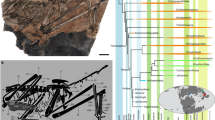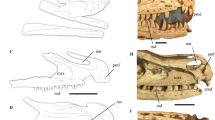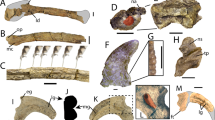Abstract
The evolutionary history of Maniraptora, the clade of carnivorous dinosaurs that includes birds and the sickle-clawed Dromaeosauridae, has hitherto been largely restricted to Late Jurassic and Cretaceous deposits on northern continents. The stunning Early Cretaceous diversity of maniraptorans from Liaoning, China1,2,3, coupled with a longevity implied by derived Late Jurassic forms such as Archaeopteryx, pushes the origins of maniraptoran lineages back to Pangaean times and engenders the possibility that such lineages existed in Gondwana. A few intriguing, but incomplete, maniraptoran specimens have been reported from South America4,5,6,7,8, Africa9 and Madagascar10. Their affinities remain contested11,12,13, however, and they have been interpreted as biogeographic anomalies relative to other faunal components of these land-masses. Here we describe a near-complete, small dromaeosaurid that is both the most complete and the earliest member of the Maniraptora from South America, and which provides new evidence for a unique Gondwanan lineage of Dromaeosauridae with an origin predating the separation between northern and southern landmasses.
This is a preview of subscription content, access via your institution
Access options
Subscribe to this journal
Receive 51 print issues and online access
$199.00 per year
only $3.90 per issue
Buy this article
- Purchase on Springer Link
- Instant access to full article PDF
Prices may be subject to local taxes which are calculated during checkout




Similar content being viewed by others
References
Hwang, S. H., Norell, M. A., Ji, Q. & Gao, K.-Q. New specimens of Microraptor zhaoianus (Theropoda: Dromaeosauridae) from Northeastern China. Am. Mus. Novit. 3381, 1–44 (2002)
Xu, X., Wang, X.-L. & Wu, X.-C. A dromaeosaurid dinosaur with filamentous integument from the Yixian Formation of China. Nature 401, 262–266 (1999)
Xu, X., Norell, M. A., Wang, X.-L., Makovicky, P. J. & Wu, X.-C. A basal troodontid from the Early Cretaceous of China. Nature 415, 780–784 (2002)
Novas, F. E. Alvarezsauridae, Late Cretaceous maniraptorans from Patagonia and Mongolia. Queensland Mus. Mem. 39, 675–702 (1996)
Novas, F. E. & Puerta, P. F. New evidence concerning avian origins from the Late Cretaceous of Patagonia. Nature 387, 390–392 (1997)
Novas, F. E. & Pol, D. New evidence on deinonychosaurian dinosaurs from the Late Cretaceous of Patagonia. Nature 3285, 858–861 (2005)
Calvo, J. O., Porfiri, J. D. & Kellner, A. W. On a new maniraptoran dinosaur (Theropoda) from the Upper Cretaceous of Neuquén, Patagonia, Argentina. Arq. Mus. Nacional. Rio de Janeiro 62, 549–566 (2004)
Novas, F. E. & Agnolín, F. L. Unquillosaurus ceibali Powell, a giant maniraptoran (Dinosauria, Theropoda) from the Late Cretaceous of Argentina. Rev. Mus. Argentino Cienc. Nat. NS 6, 61–66 (2004)
Rauhut, O. W. & Werner, C. First record of the family Dromaeosauridae (Dinosauria: Theropoda) in the Cretaceous of Gondwana (Wadi Milk Formation, Northern Sudan). Paläont. Z. 69, 475–489 (1995)
Forster, C. A., Sampson, S. D., Chiappe, L. M. & Krause, D. The theropod ancestry of birds: new evidence from the Late Cretaceous of Madagascar. Science 279, 1915–1919 (1998)
Clark, J. M., Norell, M. A. & Makovicky, P. J. in Mesozoic Birds: Above the Heads of Dinosaurs (eds Chiappe, L. M. L. & Witmer, L.) 31–64 (Univ. of California Press, Berkeley, 2002)
Novas, F. E. in Feathered Dragons: the Origin of Birds and Flight (eds Currie, P. J., Koppelhus, E., Shugar, M. & Wright, J. A.) 150–166 (Indiana Univ. Press, Bloomington, 2004)
Sereno, P. C. in New Perspectives on the Origin and Evolution of Birds: Proceedings of the International Symposium in Honor of John H. Ostrom (eds Gauthier, J. A. & Gall, L. F.) 69–98 (Peabody Mus. Nat. Hist., Yale Univ., New Haven, 2001)
Apesteguía, S., de Valais, S., González, J. A., Gallina, P. A. & Agnolin, F. L. The tetrapod fauna of ‘La Buitrera’, new locality from the basal Late Cretaceous of North Patagonia, Argentina. J. Vertebr. Paleontol. 21, 29A (2001)
Apesteguía, S. & Novas, F. E. Large Cretaceous sphenodontian from Patagonia provides insight into lepidosaur evolution in Gondwana. Nature 425, 609–612 (2003)
Carignano, A. P., Pol, D., Apesteguía, S. & Novas, F. E. La diversidad de cocodrilos de ‘La Buitrera’ (Fm. Candeleros), provincia de Río Negro. Ameghiniana 39, 7R (2002)
Coria, R. & Salgado, L. A new giant carnivorous dinosaur from the Cretaceous of Patagonia. Nature 377, 224–226 (1995)
Calvo, J. O. & Salgado, L. Rebbachisaurus tessonei sp. nov., a new Sauropoda from the Albian–Cenomanian of Argentina: new evidence on the origin of the Diplodocidae. Nat. Sci. Mus. Monogr. 15, 13–45 (1995)
Corbella, H., Novas, F. E., Apesteguía, S. & Leanza, H. A. First fission-track age for the dinosaur-bearing Neuquén Group (Upper Cretaceous), Neuquén basin, Argentina. Rev. Mus. Argentino Cienc. Nat. NS 6, 227–232 (2004)
de Valais, S. & Apesteguía, S. Dientes asignables a Giganotosaurus (Carcharodontosauria, Theropoda) provenientes de ‘La Buitrera’, Fm. Candeleros, Provincia de Río Negro. Ameghiniana 38, 9R (2001)
Gallina, P. A., Apesteguía, S. & Novas, F. E. ¿Un elefante bajo la alfombra? Los Rebbachisauridae (Sauropoda, Diplodocimorpha) del Cretácico de Gondwana. Nuevas evidencias en ‘La Buitrera’ (Fm. Candeleros), provincia de Río Negro. Ameghiniana 39, 10R (2002)
Currie, P. J. New information on the anatomy and relationships of Dromaeosaurus albertensis (Dinosauria: Theropoda). J. Vertebr. Paleont. 15, 576–591 (1995)
Makovicky, P. J., Norell, M. A., Clark, J. M. & Rowe, T. Osteology and relationships of Byronosaurus jaffei (Theropoda: Troodontidae). Am. Mus. Novit. 3402, 1–32 (2003)
Bonaparte, J. F. Tetrapod faunas from South America and India: A palaeobiogeographic interpretation. Proc. Indian Nat. Sci. Acad. 65, 427–437 (1999)
Novas, F. E., Canale, J. I. & Isasi, M. Giant deinonychosaurian theropod from the Late Cretaceous of Patagonia. J. Vertebr. Paleont. 24 (Suppl.), 98A (2004)
Bonaparte, J. F. History of the terrestrial Cretaceous vertebrates of Gondwana. Actas IV Congr. Argentino Paleontol. Bioestrat. 4, 63–95 (1986)
Brochu, C. A. & Norell, M. A. Temporal congruence and the origin of birds. J. Vertebr. Paleont. 20, 197–200 (2000)
Goloboff, P.A. NONA v.2.0. (published by the author, S.M. de Tucumán, Argentina, 1993).
Nixon, K. Winclada (BETA) v.0.9.9. (published by the author, Ithaca, New York, 2000).
Sereno, P. C. A rationale for phylogenetic definitions, with application to the higher-level taxonomy of Dinosauria. N. Jb. Geol. Paläont. Abh. 210, 41–83 (1998)
Acknowledgements
We thank the Avelás and Salinas families, C. Muñoz, L. Fernández and the 2004 La Buitrera field crew for their help in the field; J. A. González, P. Chiarelli, M. Brown, J. Holstein, L. Herzog, A. Shinya, C. Van Beek and D. Wagner for preparing the holotype; J. Weinstein for photography, M. H. Donnelly for retouching Fig. 1; J. González for the reconstruction of Buitreraptor; S. de Valais for help and discussion during the early stages of this work; D. Pol for reading the manuscript and providing advice; and F. E. Novas and R. A. Coria for providing access to materials in their care. Fieldwork and preparation was facilitated by the Agencia Cultura of Río Negro Province and supported by The Jurassic Foundation (S.A.) and NASA (P.J.M.), and research was supported by the NSF (P.J.M.).
Author information
Authors and Affiliations
Corresponding authors
Ethics declarations
Competing interests
Reprints and permissions information is available at npg.nature.com/reprintsandpermissions. The authors declare no competing financial interests.
Supplementary information
Supplementary Notes
This file contains Supplementary Methods, Supplementary Discussion, Supplementary Data and additional references. (DOC 243 kb)
Rights and permissions
About this article
Cite this article
Makovicky, P., Apesteguía, S. & Agnolín, F. The earliest dromaeosaurid theropod from South America. Nature 437, 1007–1011 (2005). https://doi.org/10.1038/nature03996
Received:
Accepted:
Issue Date:
DOI: https://doi.org/10.1038/nature03996
This article is cited by
-
A new Cretaceous thyreophoran from Patagonia supports a South American lineage of armoured dinosaurs
Scientific Reports (2022)
-
The first theropod dinosaur (Coelurosauria, Theropoda) from the base of the Romualdo Formation (Albian), Araripe Basin, Northeast Brazil
Scientific Reports (2020)
-
New theropod dinosaur from the Upper Cretaceous of Patagonia sheds light on the paravian radiation in Gondwana
The Science of Nature (2020)
-
A new alvarezsaurian theropod from the Upper Jurassic Shishugou Formation of western China
Scientific Reports (2019)
-
Halszkaraptor escuilliei and the evolution of the paravian bauplan
Scientific Reports (2019)
Comments
By submitting a comment you agree to abide by our Terms and Community Guidelines. If you find something abusive or that does not comply with our terms or guidelines please flag it as inappropriate.



